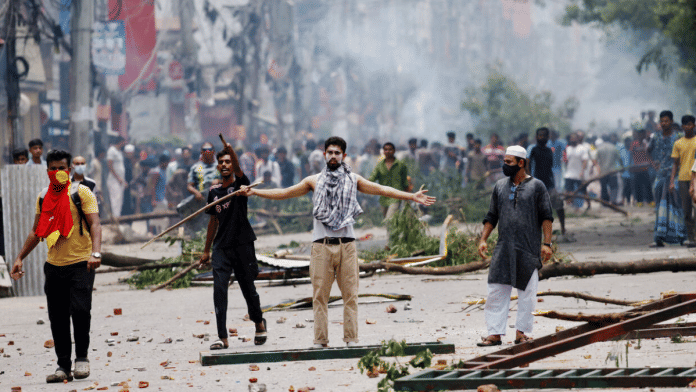New Delhi: The Sheikh Hasina-led Awami League was directly responsible for widespread human rights abuse during the 2024 protests, a United Nations fact-finding report, released Wednesday, revealed.
The 100-page report, titled ‘Human Rights Violations and Abuses related to the Protests of July and August 2024 in Bangladesh’, published by the UN’s Office of the High Commissioner for Human Rights (OHCHR), added that Hasina’s government, with senior officials’ full knowledge, orchestrated a brutal response to the protests, using live ammunition and excessive force.
At least 1,400 people were killed, many by security forces, and thousands more injured, with children and women among the most affected, it said.
“There is reasonable grounds to believe that the former government, and its security and intelligence apparatus, together with violent elements associated with the Awami League, systematically engaged in serious human rights violations, including hundreds of extrajudicial killings, other use of force violations involving serious injuries to thousands of protesters, extensive arbitrary arrest and detention, and torture, and other forms of ill-treatment,” the report read.
The OHCHR’s conclusions and recommendations are based on over 230 in-depth interviews with victims and witnesses, conducted both in Bangladesh and online. Thirty-six interviews were held with government officials, security sector representatives and political party members, including several former and current senior officials with direct knowledge of the events.
The findings were supported by verified videos, photos, forensic medical analysis, weapons assessments and other evidence.
The report, however, noted that while there are reasonable grounds to believe that specific incidents or patterns of behaviour took place, this level of proof is lower than what is needed to establish individual guilt in criminal trials even though it justifies further criminal investigation by appropriate authorities.
The UN High Commissioner for Human Rights, Volker Türk, had initially proposed a fact-finding mission in a letter to then Prime Minister Sheikh Hasina on 23 July, 2024, but received no response, the report added. On 14 August, 2024, Dr Mohammed Yunus, chief adviser of the interim government, formally requested the OHCHR’s investigation.
Also Read: Yunus govt launches ‘Operation Devil Hunt’ to weed out ‘destabilising’ forces after fresh violence
‘Hasina asked to kill & hide bodies of protestors’
The Hasina government allegedly actively suppressed information about the violence. Internet shutdowns were imposed to prevent protesters from organising and to limit the dissemination of evidence of the abuses, the report showed.
Additionally, security forces, including intelligence agencies like the Directorate General of Forces Intelligence (DGFI) and National Security Intelligence (NSI), were implicated in the abduction and torture of protest leaders, as well as in obstructing medical care for the injured.
The violence was not limited to government forces.
The Awami League has been accused of mobilising its student wing, the Bangladesh Chhatra League, to attack and intimidate protesters. Armed with blunt weapons, machetes and firearms, these groups, alongside security forces, violently suppressed demonstrations.
The unrest began in July 2024, when students across Bangladesh protested a government decision to reinstate a controversial civil service job quota. What started as a student movement soon spiralled into a broader anti-government uprising.
In response, security forces, including the police, Rapid Action Battalion (RAB), and Border Guard Bangladesh (BGB), used deadly force to suppress the protests. Despite receiving regular reports about the excessive use of force, the report claimed, Hasina continued to authorise violent actions, even instructing officials to “kill and hide the bodies” of protesters.
“Senior official testimony indicated that the prime minister herself told security force officials to kill protesters to quell the protests, and specifically demanded to ‘arrest the ringleaders of the protests, the troublemakers, kill them and hide their bodies’,” the report read.
A “core committee”, led by then Home Minister Asaduzzaman Khan Kamal, allegedly coordinated violent attacks by security agencies to crush the nationwide protests in mid-2024. This committee included high-ranking officials, like former police chief Chowdhury Abdullah Al-Mamun, former BGB Director General Major General A.K.M. Nazmul Hasan, and others.
The report noted that Kamal gave direct orders for human rights violations, including telling the BGB to use lethal force against protesters. Video evidence showed police shooting demonstrators.
Hasina, 77, is in India, defying an arrest warrant for trial in Bangladesh for crimes against humanity.
Retaliatory violence, attack on minorities
According to the report, retaliatory violence surged after the fall of the government in August 2024, particularly targeting Awami League officials, police and minority groups. Protests turned deadly, with incidents like mob lynchings and attacks on police stations.
Attacks against police and government officials intensified after Hasina’s departure on 5 August, leading to the destruction of hundreds of police stations and deaths of dozens of officers. There were also violent assaults on Awami League offices and homes, and journalists perceived as pro-government were attacked.
Hindu and indigenous communities faced widespread violence, with homes, temples and businesses looted or destroyed in several districts. Ahmadiyya Muslims and indigenous groups in the Chittagong Hill Tracts also endured targeted violence. Meanwhile, attacks on religious places of worship—especially Hindu temples—were reported across multiple regions.
These included targeted attacks by political parties like Bangladesh Nationalist Party (BNP) and Jamaat-e-Islami.
“Some local members and supporters of the BNP and Jamaat-e-Islami opposition parties bear responsibility for human rights abuses committed during revenge attacks, including against members of the Hindu community,” the report said.
It also called for an independent human rights screening mechanism to ensure no security personnel accused of abuses is nominated for peacekeeping. It also urged the government to preserve evidence, initiate proceedings against those hiding it, disband the RAB and prevent armed forces from handling domestic security without parliamentary approval.
(Edited by Mannat Chugh)







The UN seems to have been deeply penetrated by the Clinton-Soros mafia.